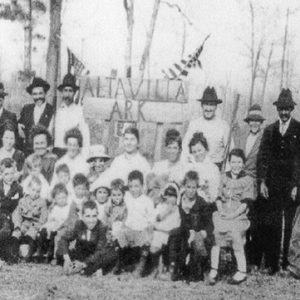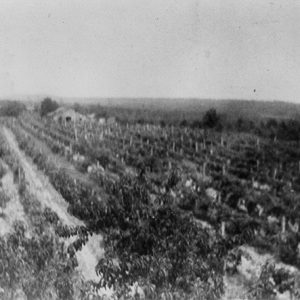calsfoundation@cals.org
Little Italy (Pulaski and Perry Counties)
Little Italy’s prominence in Arkansas history is attributed to its role in European immigration to Arkansas and, more importantly, its wine industry. The area boasted four wineries within a mile of one another and produced thousands of gallons of alcohol yearly. The wine-making Italians of Little Italy provided central Arkansans with a clean, reliable source of alcohol during Prohibition. Due to the community’s central location, it gained much attention as a place where alcohol could be purchased. The area also gained notoriety for the rough atmosphere the clientele who frequented its wineries afforded.
Little Italy was founded in 1915 by a group of Italian immigrants who had originally settled in Chicago and Upper Peninsula Michigan at the turn of the twentieth century. The five original families sought to better their chances for success in America by moving from their cramped tenements and dangerous factory jobs to a more agricultural setting. In addition, this move offered a break from the crime-ridden, over-populated cities of the Midwest and allowed the Italians to establish vineyards in the foothills of the Ouachita Mountains, which were reminiscent of their native mountainous villages in northern Italy. They named the town Alta Villa and slowly began to clear the rocky soil to enable the establishment of the local wine industry. Within the next decade, ten more families joined the village, bringing the number of families to fifteen. It was around this time that the name was changed to Little Italy to accommodate the growing town as it strived to become more Americanized. Soon, St. Francis of Assisi Catholic Church was founded with the permission of Bishop John B. Morris and the Diocese of Little Rock to serve as the community’s focal point and perpetuate the Italians’ intense Catholic faith.
Prohibition in 1919 hampered the early attempts by the Italians to make their vineyards profitable. Throughout Prohibition, many inhabitants continued to make wine, as well as bootleg whiskey from the hulls of pressed grapes. Local anti-immigrant and anti-Catholic attitudes were quelled during this time due to the willingness of the Italians to provide the non-Italian locals with illegal liquor. At the same time, others turned to legal methods of moneymaking and sold their grape harvest by the basket to stores in Little Rock (Pulaski County) and other regional areas via locomotive. By the end of Prohibition in 1933, hundreds of acres of vineyards were in full, mature production.
Despite a population of less than 100, the town was home to four bonded wineries, with several thousands of gallons of port and claret wine bottled annually. The wineries included the Segalla Winery (located in dry Perry County), the Balsam Winery, the Solda and Vaccari Winery, and the Ghidotti Winery. In addition to the four wineries, Little Italy also attracted non-Italian locals by sporting two “beer joints” and a dance hall, each outfitted with a bocce court. Because of this heavy concentration of alcohol, the town gained a reputation as a volatile area due to numerous brawls and similar criminal actions.
By the 1950s, the wine industry dwindled due to diseased grape vines and the subsequent lack of profit, which forced the younger generation to seek jobs elsewhere. Many descendants of the original families still live within the community, and St. Francis of Assisi Catholic Church remains the focal point of the community, hosting an annual spaghetti dinner. Aside from the familial descendants, the community is now a residential area for people looking to live outside of Little Rock, located sixteen miles away. In 2006, An Enchanting Evening opened as a bed and breakfast in Little Italy; it added a wedding venue in 2008 and a licensed winery in 2014.
Residents began a campaign for the incorporation of their community, filing the papers for incorporation in May 2015. However, the Sierra Club and Central Arkansas Water opposed the incorporation of the community out of fears that it could lead to the commercial development of the larger watershed. On February 26, 2016, Pulaski County judge Barry Hyde denied the motion for incorporation. The community lost its appeal of this ruling on November 28, 2018.
For additional information:
Dorer, Chris. “A Bootlegger’s Oasis: Central Arkansas’s Craving for Little Italy’s Prohibition-Era Concoctions.” Pulaski County Historical Review 65 (Spring 2017): 3–10.
———. Little Italy. Charleston, SC: Arcadia Publishing, 2015.
Dorer, Christopher A. Boy the Stories I Could Tell: A Narrative History of the Italians of Little Italy, Arkansas. Winfield, KS: Central Plains Book Manufacturing Co., 2002.
———. “Little Italy: A Historical and Sociological Survey.” Pulaski County Historical Review 51 (Summer 2003): 43–54.
Halliburton, Arthur. “Little Italy is Still Ethnically Closely-Knit; But Town Has Lost Old World Flavor since 1915.” Arkansas Democrat. November 26, 1972, p. 3A.
Little Italy. http://www.littleitalyarkansas.com/ (accessed September 19, 2022).
Price, Chris. “Immigrant Catholics Founded Little Italy 100 Years Ago.” Arkansas Catholic, August 11, 2022. https://www.arkansas-catholic.org/news/article/7535/Immigrant-Catholics-founded-Little-Italy-100-years-ago (accessed September 19, 2022).
Schnedler, Jack. “Time-Honored Tradition.” Arkansas Democrat-Gazette, September 30, 2025, pp. 1E, 6E. Online at https://www.arkansasonline.com/news/2025/sep/29/arkansas-sightseeing-little-italys-96th-italian/ (accessed October 1, 2025).
Tebbetts, Diane Ott. “Transmission of Folklife Patterns in Two Rural Arkansas Ethnic Groups: The Germans and Italians in Perry County.” PhD diss., Indiana University, 1987.
Terry, Bill. “A Typical Night at Little Italy: Sausages, Beer, Bourbon, and Gas.” Union Station Times, August 1975, pp. 11–12, 29.
Womack, Patsy. Living the Times: A Bicentennial History of Perry County. N.p.: 1976.
Woods, James M. Mission and Memory: A History of the Catholic Church in Arkansas. Little Rock: August House, 1993.
Chris Dorer
Little Rock Central High School












Comments
No comments on this entry yet.